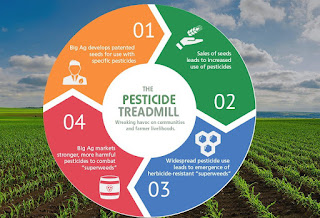Prior to World War II, many naturally occurring chemicals such as nicotine ( by planting tobacco plants in the crop field), were used as pest controlling substances for major crops in agricultural practices.
During World War II, DDT was found to be of great use in the control of malaria and other insect - borne diseases. Therefore, after the war, DDT was put to use in agriculture to control the damages caused by insects, rodents, weeds and various crop diseases. However, due to adverse effects, its use has been banned in India.
Pesticides are basically synthetic toxic chemicals with ecological repercussions. The repeated use of the same or similar pesticides give rise to pests that are resistant to that group of pesticides thus making the pesticides ineffective.
Therefore, as insect resistance of DDT increased, other organic toxins such as Aldrin and Dieldrin were introduced in the market by pesticide industry. Most of the organic toxins are water 💦🌊 insoluble and non- biodegradable.
These high persistent toxins are, therefore, transferred from lower trophic level to higher trophic level through food chain. Over the time, the concentration of toxins in higher animals reach a level which causes serious metabolic and physiological disorders.
In response to high peristence of chlorinated organic toxins, a new series of less persistent or more boi- degradable products called organo- phosphates and carbamates have been introduced in the market.
But these chemicals are severe nerve toxins and hence more harmful to humans. As a result, there are reports of some pesticides related deaths are reports of some pesticides related deaths of agricultural field workers.
Insects have because resistant to these insecticides also. The insecticide industry is engaged in developing new groups of insecticides. But one has think, is this only solution to pest menace?
These days, the pesticide industry has shifted its attention to herbicides such as sodium chorate, sodium arsinite and many others. During the first half of the last century, the shift mechanical to chemical weed control had provided the industry with flourishing economic market. But one must remember that these are also not environment friendly.
Most herbicides are toxic to mammals but are not as persistent as organo- chlorides. These chemicals decompose on a few months. Like organo - chlorides. These too became concerterted in the food web. Some herbicides cause birth defects.
Studies show that corn- field sprayed with herbicides more prone to insects attack and plants diseases than fields that are weeded manually.
Perticides and herbicides represent only a very small portion of widespread chemical pollution. A large of widespread chemical that are used regularly in chemical and industrial processes for manufacturing activities are finally released in the atmosphere in one or other form.












